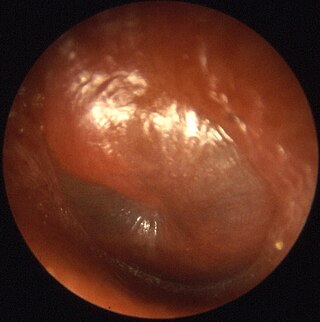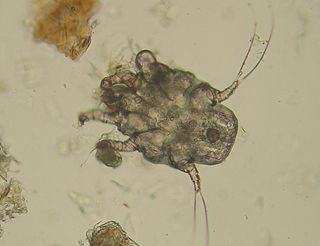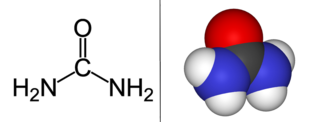Urea, also called carbamide, is an organic compound with chemical formula CO(NH2)2. This amide has two amino groups joined by a carbonyl functional group. It is thus the simplest amide of carbamic acid.

Otitis media is a group of inflammatory diseases of the middle ear. One of the two main types is acute otitis media (AOM), an infection of rapid onset that usually presents with ear pain. In young children this may result in pulling at the ear, increased crying, and poor sleep. Decreased eating and a fever may also be present. The other main type is otitis media with effusion (OME), typically not associated with symptoms, although occasionally a feeling of fullness is described; it is defined as the presence of non-infectious fluid in the middle ear which may persist for weeks or months often after an episode of acute otitis media. Chronic suppurative otitis media (CSOM) is middle ear inflammation that results in a perforated tympanic membrane with discharge from the ear for more than six weeks. It may be a complication of acute otitis media. Pain is rarely present. All three types of otitis media may be associated with hearing loss. If children with hearing loss due to OME do not learn sign language, it may affect their ability to learn.

Earwax, also known by the medical term cerumen, is a waxy substance secreted in the ear canal of humans and other mammals. Earwax can be many colors, including brown, orange, red, yellowish, and gray. Earwax protects the skin of the human ear canal, assists in cleaning and lubrication, and provides protection against bacteria, fungi, particulate matter, and water.

Benzocaine, sold under the brand name Orajel amongst others, is a local anesthetic, belonging to the amino ester drug class, commonly used as a topical painkiller or in cough drops. It is the active ingredient in many over-the-counter anesthetic ointments such as products for oral ulcers. It is combined with antipyrine to form A/B ear drops. In the US, products containing benzocaine for oral application are contraindicated in children younger than two years old. In the European Union, the contraindication applies to children under 12 years of age.

Hydrogen peroxide - urea is a white crystalline solid chemical compound composed of equal amounts of hydrogen peroxide and urea. It contains solid and water-free hydrogen peroxide, which offers a higher stability and better controllability than liquid hydrogen peroxide when used as an oxidizing agent. Often called carbamide peroxide in dentistry, it is used as a source of hydrogen peroxide when dissolved in water for bleaching, disinfection and oxidation.

A topical medication is a medication that is applied to a particular place on or in the body. Most often topical medication means application to body surfaces such as the skin or mucous membranes to treat ailments via a large range of classes including creams, foams, gels, lotions, and ointments. Many topical medications are epicutaneous, meaning that they are applied directly to the skin. Topical medications may also be inhalational, such as asthma medications, or applied to the surface of tissues other than the skin, such as eye drops applied to the conjunctiva, or ear drops placed in the ear, or medications applied to the surface of a tooth. The word topical derives from Greek τοπικόςtopikos, "of a place".
Tooth whitening or tooth bleaching is the process of lightening the color of human teeth. Whitening is often desirable when teeth become yellowed over time for a number of reasons, and can be achieved by changing the intrinsic or extrinsic color of the tooth enamel. The chemical degradation of the chromogens within or on the tooth is termed as bleaching.

Ear pain, also known as earache or otalgia, is pain in the ear. Primary ear pain is pain that originates from the ear. Secondary ear pain is a type of referred pain, meaning that the source of the pain differs from the location where the pain is felt.
Burow's solution is an aqueous solution of aluminium triacetate. It is available in the U.S. as an over-the-counter drug for topical administration, with brand names including Domeboro, Domeboro Otic, Star-Otic, and Borofair. The preparation has astringent and antibacterial properties and may be used to treat a number of skin conditions, including insect bites and stings, rashes caused by poison ivy and poison sumac, swelling, allergies, and bruises. However, its main use is for treatment of otitis, including otomycosis.

Ear mites are mites that live in the ears of animals and humans. The most commonly seen species in veterinary medicine is Otodectes cynotis. This species, despite its name, is also responsible for 90% of ear mite infections in felines.

Ciprofloxacin/dexamethasone (Ciprodex) is an antibiotic/steroid combination medication. It contains the synthetic broad-spectrum antibacterial agent, ciprofloxacin hydrochloride (0.3%), combined with the anti-inflammatory corticosteroid, dexamethasone (0.1%), in a sterile, preserved suspension for otic use.

Ingrown hair is a condition where a hair curls back or grows sideways into the skin. The condition is most prevalent among people who have coarse or curly hair. It may or may not be accompanied by an infection of the hair follicle (folliculitis) or "razor bumps", which vary in size. While ingrown hair most commonly appears in areas where the skin is shaved or waxed, it can appear anywhere. Anything that causes the hair to be broken off unevenly with a sharp tip can cause ingrown hairs. Ingrown hairs are also caused because of lack of natural exfoliation in the skin.

Ear drops are a form of topical medication for the ears used to treat infection, inflammation, impacted ear wax and local anesthesia. They are commonly used for short-term treatment and can be purchased with or without a prescription. Before using ear drops, refer to the package insert or consult a health professional for the amount of drops to use and the duration of treatment.

Flumetasone, also known as flumethasone, is a corticosteroid for topical use. It has anti-inflammatory, antipruritic, and vasoconstrictive properties, and it is approved for human and animal use for a variety of medical conditions.
Otomycosis is a fungal ear infection, a superficial mycotic infection of the outer ear canal caused by micro-organisms called fungi which are related to yeast and mushrooms. It is more common in tropical or warm countries. The infection may be either subacute or acute and is characterized by itching in the ear, malodorous discharge, inflammation, pruritus, scaling, and severe discomfort or ear pain. The mycosis results in inflammation, superficial epithelial exfoliation, masses of debris containing hyphae, suppuration, and pain. Otomycosis can also cause hearing loss.

Docusate is the common chemical and pharmaceutical name of the anion bis(2-ethylhexyl) sulfosuccinate, also commonly called dioctyl sulfosuccinate (DOSS).
Antipyrine and benzocaine ear drops is a medication for the treatment of ear pain caused by otitis media. It combines antipyrine, an NSAID, and benzocaine, a local anaesthetic in order to treat ear pain, alongside hydroxyquinoline sulfate, an antiseptic and preservative. Its trade names include Auralgan, Aurodex, Auroto, among others, and is abbreviated as A/B otic drops.

Otitis externa, also called swimmer's ear, is inflammation of the ear canal. It often presents with ear pain, swelling of the ear canal, and occasionally decreased hearing. Typically there is pain with movement of the outer ear. A high fever is typically not present except in severe cases.

Urea, also known as carbamide-containing cream, is used as a medication and applied to the skin to treat dryness and itching such as may occur in psoriasis, dermatitis, or ichthyosis. It may also be used to soften nails.

Finafloxacin (Xtoro) is a fluoroquinolone antibiotic. In the United States, it is approved by the Food and Drug Administration to treat acute otitis externa caused by the bacteria Pseudomonas aeruginosa and Staphylococcus aureus.
















